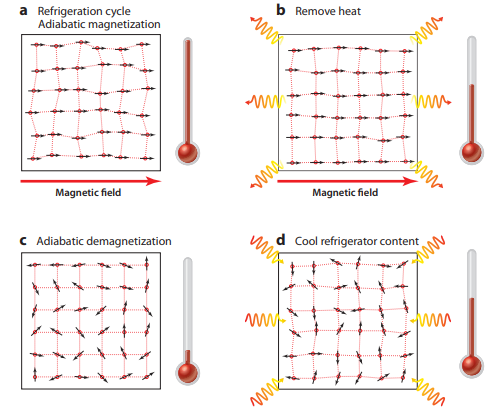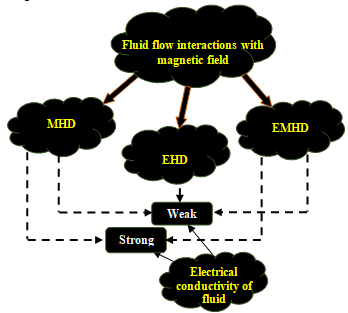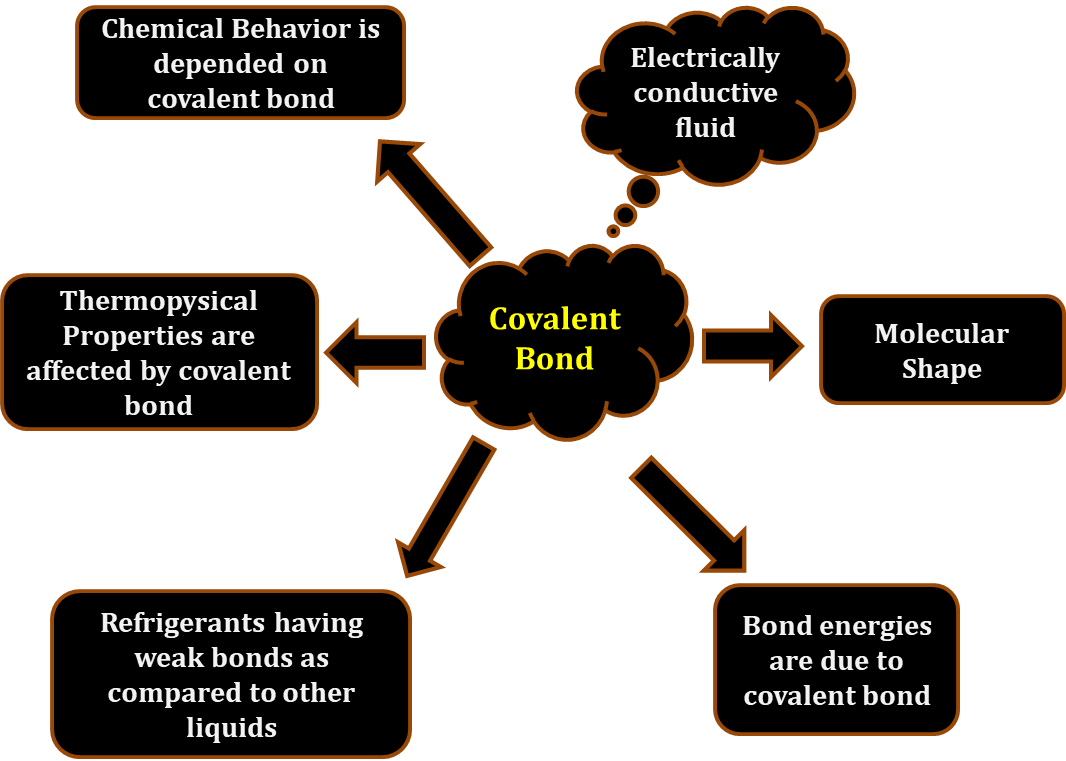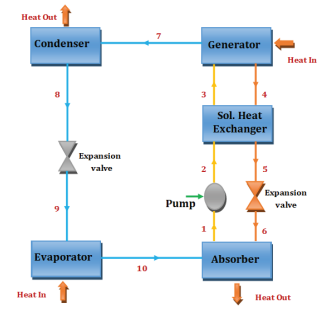Ijraset Journal For Research in Applied Science and Engineering Technology
- Home / Ijraset
- On This Page
- Abstract
- Introduction
- Conclusion
- References
- Copyright
Review of Magnetization Impacts on Vapor Absorption Refrigeration Systems
Authors: Rahul G. Deshmukh, Kirti K. Kamble, Prashant S. Raut
DOI Link: https://doi.org/10.22214/ijraset.2024.64473
Certificate: View Certificate
Abstract
Amidst the ongoing maintainable energy revolution, reducing energy consumption in vapor absorption refrigeration system (VARS) has become a critical application part. Over the past several decades, extensive research has been devoted to these systems. This study presents a thorough classification and review of the existing literature on magnetized refrigeration systems, specifically focusing on VARS. The paper explores the effects of magnetic fields on fluid flow interactions, categorizing the research into Electro-Hydrodynamics (EHD) and Magneto-Hydrodynamics (MHD). It highlights the distinctive impacts of magnetic fields on the thermophysical properties of electrically conducting fluids. Additionally, the article delves into the fundamental mechanisms behind the influence of magnetization on these properties. The review encompasses experimental studies conducted over the last two decades regarding the effects of magnetization on VARS.
Introduction
I. INTRODUCTION
Use of magnetic treatment is recognised for inducing the characteristics of several materials, mainly producing modifications in temperature. The main source behind mentioned behaviour is the magneto-caloric effect (MCE), which includes an upsurge in temperature when a magnetization is given and a consequent decrease once the contact is detached, affecting the thermodynamically properties, such as entropy and heat content of the material. Fig. 1 illustrates phases of magnetic refrigeration cycle established on MCE. Though the influences of magnetic treatment on fluids remain partially unexplored, it is well-established that exposure to a magnetization induces substantial changes in their behaviour.
A wealth of literature supports the notion that magnetic fields can influence thermodynamic properties. Many investigations have examined the application of magnetization to improve efficiency across diverse fields, including water treatment, fuel lines, diesel engines, oil processing, refrigeration, and natural gas furnaces [2-7]. The effect of magnetization on VARS was originally witnessed by researcher Niu Xiaofeng in 2007 during a numerical analysis of falling film absorption with ammonia–water in magnetic field on the impact of magnetic treatment of refrigerant blends [8].

Fig. 1 Phases of magnetic refrigeration cycle established on MCE [1]
In the last two decades, there has been a growing interest in the advancement of MHD technology, marked by both theoretical and practical innovations. However, the commercialization of this technique has not kept pace with its development. Examining recent breakthroughs in MHD technology is crucial for understanding its evolution and setting the stage for future advancements. Importantly, there is a noticeable gap in the literature regarding review articles that specifically address the impact of MHD on refrigerants and the subsequent enhancements in refrigeration system performance. The magnetic treatment of conductive fluids and its potential for optimizing system efficiency have garnered significant attention from researchers in the MHD field, making a thorough discussion necessary.
The primary aim of this study is to provide an extensive classification of fluid interactions with various magnetic fields, presenting a detailed analysis of both experimental and theoretical research on the effects of MHD on electrically conducting fluids in recent years. Furthermore, the paper includes an in-depth review of MHD applications in VARS. A thorough assessment of MHD's effects on water is also conducted, emphasizing key benefits and exploring potential research directions. This work is designed to be a valuable resource, offering critical insights for researchers in the field and establishing a solid groundwork for future studies.
II. IMPACTS OF MAGNETIC FIELDS ON THE BEHAVIOUR OF WATER
This section examines research results concerning the impact of magnetization on electrically conductive fluids, such as water, and discusses their potential implications for a range of applications.
A. Overview of Fluid-Magnetic Field Interactions
While the investigation of magnetic field effects on electrically conductive fluids is still evolving, it is clear that substantial changes occur when these fluids move through magnetic fields. This study categorizes fluid interactions with magnetic fields into two main areas: Electro-Hydrodynamics (EHD), which examines the influence of electric forces, and Magneto-Hydrodynamics (MHD), which focuses on the effects of magnetization on electrically conducting fluids. Additionally, the interplay between electric fields and magnetization in electrically conductive fluids, also known as magnetic fluids, is addressed under the umbrella of Electro-Magneto-Hydro-Dynamics (EMHD) [9]. The classification of interactions between electrically conducting fluids and various magnetic exposures is illustrated in Fig. 2.

Fig. 2 Categorization of fluid-magnetic interactions [5]
B. The role of MHD in shaping the thermophysical properties of fluids
The study of interactions between electrically conductive fluids and magnetic fields produced by permanent magnets is known as Magneto-Hydrodynamics. When such a fluid moves through a stationary external magnetic field applied perpendicularly, it generates electrical currents within the fluid. These induced currents then interact with the external magnetic field, resulting in a magnetic force that alters the heat transfer characteristics.
The application of a magnetic field interferes with molecular clusters, resulting in modifications to the thermophysical properties of electrically conductive fluids. This includes variations in surface tension, boiling point, specific heat, viscosity, thermal conductivity, and other related characteristics. Table 1 illustrates the effects of magnetization on the thermophysical properties of fluids. Fig. 3 depicts how magnetization causes the de-clustering of conducting fluids, leading to the formation of smaller particles and Fig. 4 shows dependency of fluid properties on covalent bond.

Fig. 3 Breaking of molecular cluster via magnetic exposure [10]
 Fig. 4 Importance of covalent bond in electrically conducting fluids
Fig. 4 Importance of covalent bond in electrically conducting fluids
Table 1
Influence of magnetization on thermophysical characteristics of different fluids with weak electrical conductivity
|
S.N. |
Investigators |
Fluids |
Magnetic treatment |
Main properties |
Findings |
|
01 |
Tung et.al. [11] |
Crude Oil |
Permanent magnets (up to 0.85 Tesla) |
1. Viscosity. |
1. Decrease in the viscosity of crude oil. |
|
02 |
Tipole et al. [12] |
Diesel fuel |
Permanent magnets (0.3 Tesla). |
1. Viscosity |
1. The disruption of molecular clusters leads to a decrease in the viscosity of the fuel. |
|
03 |
Niu, et al. [13] |
NH4OH solution |
Electromagnet (0.1326 to 0.2613 Tesla) |
1. Viscosity 2. Heat conductivity |
1. A reduction in viscosity, conversely, results in an increase in heat conductivity. |
|
04 |
Wang et al.[14] |
Tap H2O |
Permanent magnets (0.1 Tesla, 0.2 Tesla, 0.3 Tesla, & 0.4 Tesla). |
1. Specific heat 2. Boiling point |
1. Decrease in the specific heat and boiling point of tap water |
|
05 |
Tipole et al. [15] |
R-404A |
Permanent magnets (0.3 Tesla). |
1. Viscosity |
1. Drop in the viscosity |
|
06 |
Deshmukh et al. [10] |
R-134a |
Permanent magnets (0.3 Tesla and 0.72 Tesla) |
1. Viscosity |
1. Magnetic exposure reduces viscosity of refrigerant. |
III. THE ROLE OF MAGNETIZATION IN ENHANCING VARS PERFORMANCE
Absorption refrigeration technology has emerged as a compelling alternative to traditional vapor compression refrigeration systems (VCRS), attracting growing interest from researchers and engineers in recent years. This method harnesses thermal energy—sourced from low-grade energy reservoirs or solar power—to provide cooling, offering versatility, such as utilizing waste heat from an internal combustion (IC) engine [16]. The essential components of VARS include the generator, pump, absorber, solution heat exchanger, condenser, expansion valves, and evaporator, as illustrated in Fig. 5.

Fig. 5 Graphic representation of VARS [17]
Numerous studies, such as those conducted by Niu et al. [18-20] and Jadhav et al. [21], have demonstrated the effectiveness of using magnetic fields to improve the performance of VARS. Table 2 summarizes the effects of magnetization on VARS performance.
Niu et al. [18] performed a numerical study examining the effects of magnetization on the absorption process using a mathematical model for ammonia-water falling film absorption. This model accounts for macroscopic magnetic field forces while incorporating changes in the physical properties of the ammonia-water solution during absorption, variations in film thickness, and convection within the liquid film. The numerical findings reveal that the magnetic field positively influences ammonia-water falling film absorption. Notably, with a magnetization strength of 3 T at the solution's inlet, there is a 1.3% increase in the concentration of the ammonia-water solution at the outlet, leading to a 5.9% improvement in absorbability. In a basic ammonia-water absorption refrigeration system, the coefficient of performance (COP) increases by 4.73%, alongside an 8.3% decrease in the circulation ratio.
Niu et al. [19] conducted an experimental study on ammonia-water falling film absorption subjected to magnetic fields of varying strengths, orientations, and operational conditions. The results demonstrated that, under a downward magnetic field, the outlet concentration of the ammonia-water solution, the outlet temperature of the cooling water, and the rates of heat and mass absorption were significantly higher compared to those observed in the absence of a magnetic field. In contrast, these parameters decreased under an upward magnetic field. This indicates that a magnetic field aligned with the direction of the falling film facilitates enhanced absorption, while a field opposing the film direction hampers the absorption process. Furthermore, the findings revealed that the effects of magnetization on absorption are more pronounced in solutions with lower inlet concentrations.
Niu et al. [20] examined the effects of magnetic exposure on ammonia absorption within an ammonia-water absorption refrigeration system. Their experimental study focused on how the viscosity and thermal conductivity of the ammonia-water solution were affected by the presence of a magnetic field. Magnetization was applied using an electromagnet with intensities ranging from 1326.4 to 2613.5 Gauss, with durations of 10, 20, and 30 minutes tested. The findings indicated that magnetization resulted in a reduction in the viscosity of the ammonia-water solution, with more pronounced decreases occurring at higher magnetic field strengths and longer exposure times. Conversely, the thermal conductivity improved with extended magnetization durations and increased magnetic intensity. These alterations in viscosity and thermal conductivity were attributed to the Lorentz force and the disruption of hydrogen bonding within the microstructure of the magnetized ammonia-water solution
Odunfa et al. [22] investigated methods to enhance absorption in refrigeration systems, specifically focusing on the role of magnetization. This research introduces a model for improving magnetization in ammonia-water absorption systems, utilizing a numerical approach based on a finite difference scheme derived from conservation equations and mass transport principles. The momentum equation was augmented to include a macroscopic magnetic field force. The model was validated against existing literature data. The study examined the variations in the physical properties of the ammonia solution during the absorption process, both in the direction of the falling film and throughout its thickness. The results indicated that magnetization positively influenced ammonia-water falling film absorption, with improved absorption performance associated with higher magnetic intensities. Remarkably, the coefficient of performance (COP) of a basic ammonia solution absorption refrigeration system showed increases of 1.9% and 3.6% for magnetic inductions of 1.4 and 3.0 Tesla, respectively.
Triché et al. [23] performed extensive experimental and numerical studies on heat and mass transfer within a falling film absorber, using a plate heat exchanger designed for ammonia-water absorption. The research involved a prototype ammonia-water absorption chiller (illustrated in Fig. 6) to analyze absorber performance under real operating conditions. The ammonia-water solution flowed along the plates in a falling film configuration, while vapor flowed co-currently and the coolant fluid flowed counter-currently. The study provided a concise overview of the absorber’s operation, supported by analyses based on temperature measurements along the falling film. To enhance their experimental findings, the researchers developed a mathematical model and simulation tool, conducting a parametric study that examined the influence of coolant mass flow rates. Validation of the model against experimental data revealed a maximum relative error of 15%. The results indicated that mass transfer during the absorption process is predominantly influenced by the resistance to mass transfer in the falling film, while the liquid-side heat transfer resistance plays a negligible role.

Fig. 6 Prototype of an ammonia-water absorption chiller [23]
Wu and Ortiz et al. [24] conducted an experimental investigation into the enhancement of vapor absorption refrigeration systems (VARS) through the application of magnetization, which facilitates the slip movement of nanoparticles within a nanofluid. The experiments took place in an adiabatic falling film absorber, utilizing a mixture of lithium bromide (LiBr)-water solution and iron (III) nanopowder, with particle sizes below 50 nm and a mass fraction of 0.17%. The findings indicated that vapor absorption rates increased by 17.6% and 4.9% when the nanofluid was circulated at flow rates of 3 L/min and 3.5 L/min, respectively, compared to the base fluid. Furthermore, the application of external magnetic fields significantly enhanced the movement of nanoparticles within the fluid, resulting in vapor absorption rates that were 1.58 times and 1.32 times higher than those observed without magnetic influence, for circulation rates of 3.5 L/min and 3.0 L/min, respectively.
Jadhav et al. [21] introduced a simulation model designed to analyze and predict magnetization patterns and magnetic flux density within pipes. The study explores various magnet configurations, such as series, parallel, and Halbach arrays, and assesses their corresponding magnetic flux densities and magnetization strengths along the pipes. By utilizing electromagnetic field simulation software, the researchers calculated a range of magnetic fields and circuit parameters, resulting in accurate insights into optimal magnet configurations. For the experimental work, neodymium-35 type magnets with consistent magnetic strength were used. The insights gained from the different magnetic arrangements are anticipated to aid in the selection of suitable magnet configurations for diffusion absorption refrigeration systems, presenting viable alternatives to traditional vapor compression refrigeration systems for domestic cooling applications.
Table 2
Influence of magnetization on performance of VARS
|
S.N. |
Researcher |
Primary fluid |
Magnetization |
Key factors |
Magnetization imapacts |
|
1 |
Niu et al. [18] |
NH4–H2O |
0 to 30000 G |
1.Absorbability |
|
|
2 |
Niu et al. [19] |
NH4–H2O |
0 to 2000 G |
1.Outlet concentration of ammonia–water, 2.Cooling water outlet temperature, 3.Absorption heat and mass |
1. In a downward magnetization, the concentration of NH4–H2O at the outlet, the temperature of the cooling water at the outlet, and the rates of heat and mass absorption are all higher than those observed without magnetization. |
|
3 |
Niu et al. [20] |
NH4–H2O |
0.1326 to 0.2613 T |
1.viscosity |
1. Drop in viscosity 2. Enhancement in heat conductivity |
|
4. |
Jadhav et al. [21] |
NH4–H2O |
1000 to 6000 G |
1.Heat absorption |
1. Halbach array improves heat absorption in contrast with other configurations |
|
5 |
Odunfa et al.[22] |
NH4–H2O |
14000 G and 30000 G |
|
1. The coefficient of performance (COP) of a basic ammonia solution absorption refrigeration system showed increases of 1.9% and 3.6% for magnetic inductions of 14000 Gauss and 30000 Gauss, respectively. |
|
6 |
Wu and Ortiz et al. [24] |
NH4–H2O |
-------- |
1.vapour absorption rates |
1. Increase in vapour absorption rate. |
Conclusion
This review article thoroughly investigates how magnetic exposure affects electrically conductive fluids, particularly in relation to their applications in VARS. It also delves into the underlying reasons for the alterations observed in the thermophysical properties of these fluids. Several key conclusions drawn from this article include: 1) Numerous applications, particularly in VARS, can benefit from magnetic treatment in terms of heat transfer, refrigerant properties, and overall performance, encouraging upcoming investigators to further explore this encouraging area. 2) Greater attention needs to be directed toward experimental studies examining the effects of magnetization on electrically conducting fluids. 3) While many researchers have studied the effects of magnetic pairs on refrigeration system performance, there is a growing necessity to investigate alternative configurations, such as ring magnets and Halbach arrays. 4) Most research efforts have focused on improving system performance, with inadequate attention given to environmental considerations. Therefore, it is essential to place more emphasis on the development of eco-friendly magnetized VARS. 5) The influence of magnetism and magnetization on VARS is still regarded as a relatively unexplored and not well-understood subject. The effects of magnetism and magnetic treatment on VARS remain a largely uncharted and poorly understood area of study.
References
[1] V. Franco, J. S. Blázquez, B. Ingale, and A. Conde, “The Magnetocaloric effect and magnetic refrigeration near room temperature: materials and models.” Annu. Rev. Mater. Res.42, 305 (2012). https://doi.org/10.1146/annurev-matsci-062910-100356 [2] Yogesh G. Joshi, Vinit Gupta, Rahul Deshmukh, Kunal Khelkar, Adesh Kolhe, Akhilesh Bhoyar, “Flow boiling heat transfer and thermophysical characteristics of graphene-POE-R134a based nanorefrigerant.” Mater. Today Proc. (2023). https://doi.org/10.1016/j.matpr.2023.08.054. [3] R.G. Deshmukh, D.R. Zanwar, Y.G. Joshi 2023. \"Impact of Magnetic Field Generated Using Neodymium-Iron-Boron Magnetic Pairs on Condensation Heat Transfer Coefficient for Tetrafluroethane (R134a).\" Mater. Today Proc. (2023). https://doi.org/10.1016/j.matpr.2023.08.220 [4] Sami, Samuel M, and Shawn Aucoin. 2003. “Effect of Magnetic Field on the Performance of New Refrigerant Mixtures.” International Journal of Energy Research 27 (3): 203–14. https://doi.org/https://doi.org/10.1002/er.868. [5] Rahul G. Deshmukh, Dinesh R. Zanwar, Sandeep S. Joshi, \"Magnetic Field Effects on Refrigeration Systems: A Comprehensive Review,\" SSRG International Journal of Mechanical Engineering, vol. 11, no. 4, pp. 18-29, 2024. [6] Deshmukh, R. G., Zanwar, D. R., & Joshi, S. S. (2024). Magnetisation effects of the Halbach array on the condensation heat transfer coefficient of 1,1,1,2-tetrafluoroethane. International Journal of Ambient Energy, 45(1). https://doi.org/10.1080/01430750.2024.2378949 [7] R. G. Deshmukh, S.A.Patil, “Performance improving techniques for VCR system: A review“ International journal for research in applied science and engineering technology Volume 6, Issue IV, April 2018. [8] Niu Xiaofeng, Du Kai, Du Shunxiang. (2007). “Numerical analysis of falling film absorption with ammonia–water in magnetic field, Applied Thermal Engineering”,https://doi.org/10.1016/j.applthermaleng.2006.12.001. [9] Kabeel, A E, Emad M S El-Said, and S A Dafea. 2015. “A Review of Magnetic Field Effects on Flow and Heat Transfer in Liquids: Present Status and Future Potential for Studies and Applications.” Renewable and Sustainable Energy Reviews 45: 830–37. [10] Rahul Deshmukh, Dinesh Zanwar, Sandeep Joshi, and Shyamal Chakrabarty. 2022. “Experimental investigations on the performance of a vapor compression refrigeration system under the influence of magnetic field generated using magnetic pair and Halbach array.” Energy Sources, Part A: Recovery, Utilization, and Environmental Effects: https://doi.org/10.1080/15567036.2021.2024302. [11] Tung, Nguyen Phuong, Van Vuong, Nguyen, Long, Bui Quang Khanh, Vinh, Ngo Quang, Hung, Pham Viet, Hue, Vu Tam, and Le Dinh Hoe. 2001. \"Studying the Mechanism of Magnetic Field Influence on Paraffin Crude Oil Viscosity and Wax Deposition Reductions.\" Paper presented at the SPE Asia Pacific Oil and Gas Conference and Exhibition, Jakarta, Indonesia, April 2001. [12] Tipole, Pralhad, A Karthikeyan, Virendra Bhojwani, Suhas Deshmukh, Harshal Babar, and Bharati Tipole. 2019. “Examining the Impact of Magnetic Field on Fuel Economy and Emission Reduction in I.C. Engines.” International Journal of Ambient Energy, September, 1–7. https://doi.org/10.1080/01430750.2019.1667434. [13] Niu, Xiaofeng, Kai Du, and Linda Xiao. 2011. “Experimental Study on the Effect of Magnetic Field on the Heat Conductivity and Viscosity of Ammonia–Water.” Energy and Buildings - ENERG BLDG 43 (May): 1164–68. https://doi.org/10.1016/j.enbuild.2010.08.005. [14] Wang, Youkai, Huinan Wei, and Zhuangwen Li. 2018. “Effect of Magnetic Field on the Physical Properties of Water.” Results in Physics 8: 262–67.https://doi.org/https://doi.org/10.1016/j.rinp.2017.12.022. [15] Tipole, Pralhad, Alagu Karthikeyan, Virendra Bhojwani, Suhas Deshmukh, Bharati Tipole, Krushad Shinde, and Advait Sundare. 2017. “Performance Analysis of Vapor Compression Cycle Water Chiller with Magnetic Flux at the Condenser Exit.” Energy and Buildings 158 (August). https://doi.org/10.1016/j.enbuild.2017.08.028. [16] Bhatti, S S & Tyagi, S. & Verma, Abhishek. (2020). Energy and Exergy Analysis of Vapour Absorption Cooling System Driven by Exhaust Heat of IC Engine. 10.1007/978-981-15-6360-7_24. [17] VERMA, A., KAUSHIK, S. C., & TYAGI1, S. K. (2023). Performance enhancement of absorption refrigeration systems: An overview. Journal of Thermal Engineering, 9(4), 1100-1113. https://doi.org/10.18186/thermal.1334225 [18] Niu Xiaofeng, Du Kai, Du Shunxiang. (2007). “Numerical analysis of falling film absorption with ammonia–water in magnetic field, Applied Thermal Engineering”,https://doi.org/10.1016/j.applthermaleng.2006.12.001. [19] Niu, Xiao & Du, Kai & Xiao, Linda. (2010). Experimental study on ammonia-water falling film absorption in external magnetic fields. International Journal of Refrigeration-revue Internationale Du Froid - INT J REFRIG. 33. 686-694. 10.1016/j.ijrefrig.2009.11.014. [20] Xiaofeng Niu, Kai Du, Fu Xiao. (2011). “Experimental study on the effect of magnetic field on the heat conductivity and viscosity of ammonia–water”, Energy and Buildings, https://doi.org/10.1016/j.enbuild.2010.08.005. [21] Sahadev Murlidhar Jadhav, Arulprakasajothi Mahalingam, Vikas Vasantrao Ugle, Logesh Kamaraj. (2022). “Increasing the waste heat absorption performance in the refrigeration system using electromagnetic effect”, Int. J. Simul. Multidisci. Des. Optim., DOI: 10.1051/smdo/2022010 [22] Odunfa, Moradeyo & Fagbenle, Richard & Oyewola, Olarenwaju & Ohunakin, Olayinka. (2014). Magnetic Field Enhancement in Ammonia-Water Absorption Refrigeration Systems. Energy and Power Engineering. 06. 54-68. 10.4236/epe.2014.64007. [23] Triché, Delphine & Bonnot, Sylvain & Perier-Muzet, Maxime & Boudéhenn, François & Demasles, Hélène & Caney, Nadia. (2017). Experimental and numerical study of a falling film absorber in an ammonia-water absorption chiller. International Journal of Heat and Mass Transfer. 111. 374-385. 10.1016/j.ijheatmasstransfer.2017.04.008. [24] Wu, Shenyi & Ortiz, Camilo. (2019). Experimental Investigation of the Effect of Magnetic Field on Vapour Absorption with LiBr-H2O Nanofluid. Energy. 193. 116640. 10.1016/j.energy.2019.116640.
Copyright
Copyright © 2024 Rahul G. Deshmukh, Kirti K. Kamble, Prashant S. Raut. This is an open access article distributed under the Creative Commons Attribution License, which permits unrestricted use, distribution, and reproduction in any medium, provided the original work is properly cited.

Download Paper
Paper Id : IJRASET64473
Publish Date : 2024-10-06
ISSN : 2321-9653
Publisher Name : IJRASET
DOI Link : Click Here
 Submit Paper Online
Submit Paper Online

